Summary of Rubber Modified Asphalt Product Specifications around ...
Summary of Rubber Modified Asphalt Product Specifications around ...
Summary of Rubber Modified Asphalt Product Specifications around ...
Create successful ePaper yourself
Turn your PDF publications into a flip-book with our unique Google optimized e-Paper software.
Shoulders and ramps are always eligible for selection as a random sample location. However, if a<br />
random sample location falls on a shoulder or ramp that is designated on the plans as not subject to In-<br />
Place air void testing, cores will not be taken for the sublot and a 1.000 pay factor will be assigned to<br />
that sublot.<br />
Unless otherwise determined, the Engineer will witness the coring operation and measurement <strong>of</strong> the<br />
core thickness. Unless otherwise approved, obtain the cores within 1 working day <strong>of</strong> the time the<br />
placement sublot is completed. Obtain two 6-in.-diameter cores side-by-side from within 1 ft. <strong>of</strong> the<br />
random location provided for the placement sublot. Mark the cores for identification. Visually inspect<br />
each core and verify that the current paving layer is bonded to the underlying layer. If an adequate bond<br />
does not exist between the current and underlying layer, take corrective action to insure that an<br />
adequate bond will be achieved during subsequent placement operations.<br />
Immediately after obtaining the cores, dry the core holes and tack the sides and bottom. Fill the hole<br />
with the same type <strong>of</strong> mixture and properly compact the mixture. Repair core holes with other<br />
methods when approved.<br />
If the core heights exceed the minimum untrimmed values listed in Table 10, trim and deliver the cores<br />
to the Engineer within 1 working day following placement operations unless otherwise approved.<br />
If the core height before trimming is less than the minimum untrimmed value shown in Table 10,<br />
decide whether or not to include the pair <strong>of</strong> cores in the air void determination for that sublot. If the<br />
cores are to be included in air void determination, trim the cores before delivering to the Engineer. If<br />
the cores will not be included in air void determination, deliver untrimmed cores to the Engineer. The<br />
placement pay factor for the sublot will be 1.000 if cores will not be included in air void<br />
determination.<br />
c. Placement Testing. Perform placement tests in accordance with Table 12. After the Engineer returns<br />
the cores, the Contractor has the option to test the cores to verify the Engineer’s test results for in-place<br />
air voids. Re-dry the cores to constant weight before testing. The<br />
allowable differences between the Contractor’s and Engineer’s test results are listed in<br />
Table 9.<br />
(1) In-Place Air Voids. The Engineer will measure in-place air voids in accordance with Tex-207-F<br />
and Tex-227-F. Before drying to a constant weight, cores may be predried using a Corelok or<br />
similar vacuum device to remove excess moisture. The Engineer will average the values obtained<br />
for all sublots in the production lot to determine the theoretical maximum specific gravity. The<br />
Engineer will use the average air void content <strong>of</strong> the 2 cores to calculate a placement pay<br />
adjustment factor.<br />
The Engineer will use paraffin coating or vacuum methods to seal the core if required by Tex-207-<br />
F. The Engineer will use the test results from the unsealed core to determine the placement pay<br />
adjustment factor if the sealed core yields a higher specific gravity than<br />
the unsealed core. After determining the in-place air void content, the Engineer will return the<br />
cores and provide test results to the Contractor.<br />
(2) Segregation (Density Pr<strong>of</strong>ile). Test for segregation using density pr<strong>of</strong>iles in accordance with Tex-<br />
207-F, Part V. Provide the Engineer with the results <strong>of</strong> the density pr<strong>of</strong>iles as they are completed.<br />
Areas defined in Section 346.4.I.3.a(4), “Miscellaneous Areas,” are not subject to density pr<strong>of</strong>ile<br />
testing.<br />
Unless otherwise approved, perform a density pr<strong>of</strong>ile every time the screed stops, on areas that are<br />
identified by either the Contractor or the Engineer as having thermal segregation, and on any visibly<br />
segregated areas. If the screed does not stop, and there are no visibly segregated areas or areas that<br />
are identified as having thermal segregation, perform a minimum <strong>of</strong> 1 pr<strong>of</strong>ile per sublot. Reduce the<br />
test frequency to a minimum <strong>of</strong> 1pr<strong>of</strong>ile per lot if 4 consecutive pr<strong>of</strong>iles are within established<br />
tolerances. Continue testing at a minimum frequency <strong>of</strong> 1 per lot unless a pr<strong>of</strong>ile fails, at which<br />
point resume testing<br />
at a minimum frequency <strong>of</strong> 1 per sublot. The Engineer may further reduce the testing<br />
frequency based on a consistent pattern <strong>of</strong> satisfactory results.<br />
The density pr<strong>of</strong>ile is considered failing if it exceeds the tolerances in Table 13. No production or<br />
placement bonus will be paid for any sublot that contains a failing density pr<strong>of</strong>ile. The Engineer<br />
167


